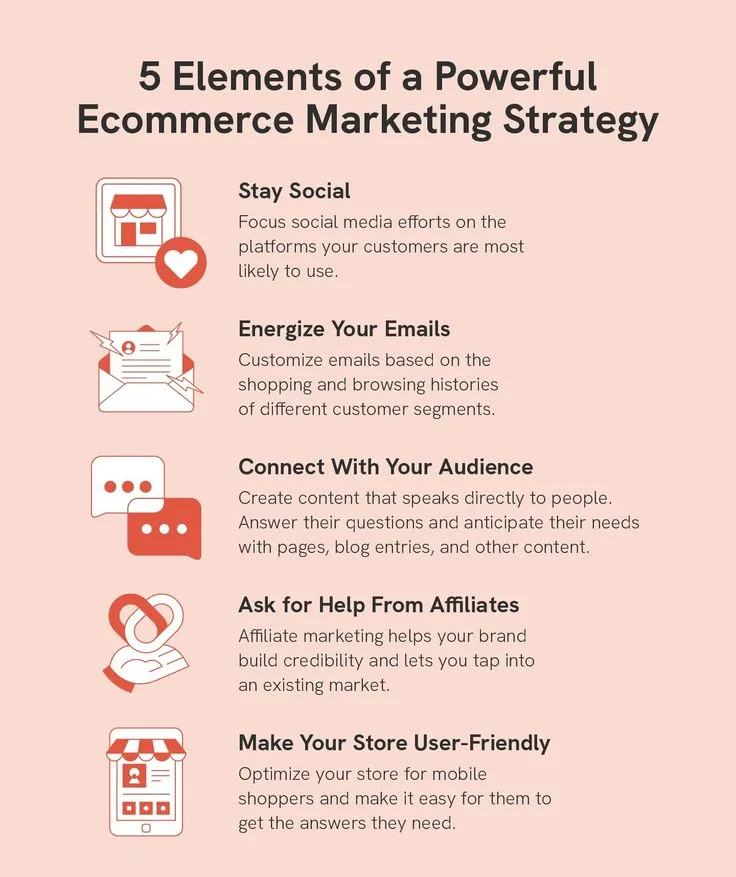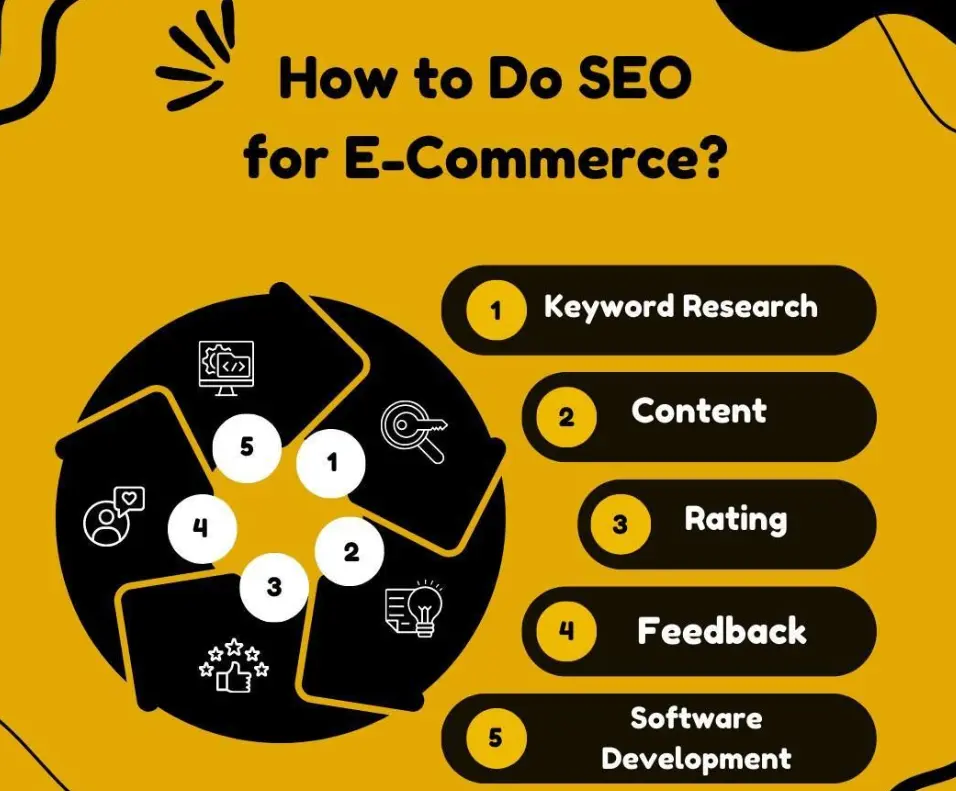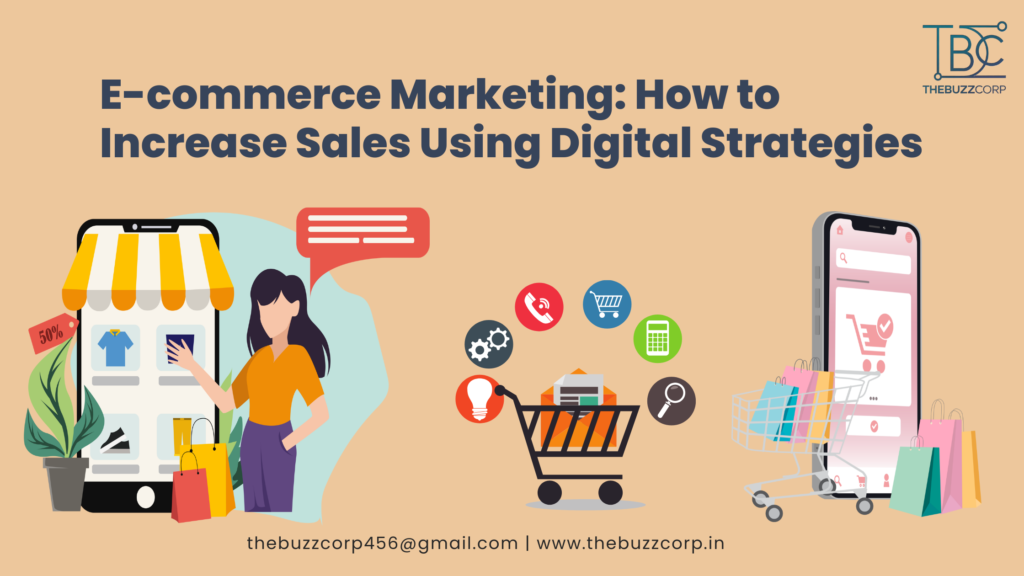E-commerce Marketing: How to Increase Sales Using Digital Strategies 🛍️
Are you an online store owner striving to boost your sales? In today’s competitive e-commerce landscape, standing out can be challenging. However, by implementing effective digital marketing strategies, you can attract more customers and increase your revenue.
What is E-commerce Marketing?
E-commerce marketing is all about promoting your online store to attract visitors and turn them into paying customers. It’s like setting up a friendly shop in the digital world where people can browse and buy your products or services.

Why is E-commerce Marketing Important?
In today’s world, more people are shopping online than ever before. To stand out, your online store needs to:
- Attract visitors: Bring people to your website.
- Engage them: Keep them interested in what you offer.
- Convert them: Encourage them to make a purchase.
- Retain them: Make them want to come back again.
Key E-commerce Marketing Strategies

Here are some simple strategies to help your online store succeed:
1. Search Engine Optimization (SEO)
Make sure your website appears in search results when people look for products like yours.
Tips:
- Use clear and relevant keywords in your product titles and descriptions.
- Create helpful content that answers common questions about your products.
2. Content Marketing
Share valuable information to build trust and attract customers.
Ideas:
- Write blog posts about how to use your products.
- Create videos showing your products in action.
3. Social Media Marketing
Use platforms like Facebook, Instagram, and Twitter to reach more people.
Tips:
- Share engaging posts about your products.
- Run special promotions for your followers.
4. Email Marketing
Send emails to keep customers informed and encourage repeat purchases.
Ideas:
- Share news about new products or upcoming sales.
- Send personalized recommendations based on past purchases.
5. Pay-Per-Click Advertising (PPC)
Place ads on search engines or social media to drive traffic to your site.
Tips:
- Target your ads to specific audiences interested in your products.
- Set a budget and monitor your ad performance regularly.
E-commerce Marketing Channels Comparison
Here’s a simple comparison of different marketing channels:
| Channel | Cost | Reach | Engagement | Conversion Rate |
| SEO | Low | High | Medium | High |
| Content Marketing | Medium | Medium | High | Medium |
| Social Media | Low | High | High | Medium |
| Email Marketing | Low | Medium | High | High |
| PPC Advertising | High | High | Medium | High |
How to Increase Sales Using Digital Strategies

1. Optimize Your Website for User Experience (UX)
A seamless and enjoyable shopping experience is crucial for converting visitors into customers.
Key Focus Areas:
- Mobile Responsiveness: Ensure your site looks and functions well on all devices.
- Fast Loading Speeds: Optimize images and reduce unnecessary scripts to speed up your site.
- Easy Navigation: Use clear menus and search functions to help users find products quickly.
2. Leverage Content Marketing
Providing valuable content can attract and engage potential customers.
Strategies:
- Blog Posts: Write articles related to your products or industry.
- How-To Guides: Offer tutorials that showcase your products’ uses.
- Customer Stories: Share testimonials and case studies.
3. Implement Email Marketing Campaigns
Email remains a powerful tool for reaching customers directly.
Tips:
- Personalize Messages: Use customer names and recommend products based on past purchases.
- Segment Your Audience: Tailor content to different customer groups.
- Include Clear CTAs: Encourage actions like “Shop Now” or “Learn More.”
4. Utilize Social Media Platforms
Engage with your audience where they spend their time online.
Approaches:
- Regular Posts: Share updates, promotions, and engaging content.
- Influencer Collaborations: Partner with influencers to reach a broader audience.
- Social Media Ads: Target specific demographics with paid advertisements.
5. Invest in Search Engine Optimization (SEO)
Improve your website’s visibility on search engines.
Focus Areas:
- Keyword Research: Identify and use terms your potential customers are searching for.
- Quality Content: Create informative and relevant content.
- Backlinks: Earn links from reputable sites to boost credibility.
6. Offer Exceptional Customer Service
Satisfied customers are more likely to return and recommend your store.
Best Practices:
- Live Chat Support: Provide instant assistance to visitors.
- Clear Return Policies: Build trust by being transparent.
- Follow-Up Emails: Check in post-purchase to ensure satisfaction.
7. Utilize Pay-Per-Click (PPC) Advertising
Drive targeted traffic to your site through paid ads.
Platforms:
- Google Ads: Appear in search results for specific keywords.
- Social Media Ads: Use platforms like Instagram and Twitter to reach specific audiences.
8. Implement Retargeting Strategies
Re-engage visitors who have previously interacted with your site.
Methods:
- Retargeting Ads: Show ads to users who left without purchasing.
- Email Reminders: Send emails about abandoned carts.
9. Analyze and Adapt Using Data
Regularly review performance metrics to inform decisions.
Tools:
- Google Analytics: Track visitor behavior and sales.
- Heatmaps: Visualize where users click and scroll on your site.
10. Enhance User Trust with Reviews and Testimonials
Positive feedback can influence potential customers’ purchasing decisions.
Strategies:
- Display Reviews Prominently: Showcase customer reviews on product pages.
- Encourage Feedback: Ask customers to leave reviews after purchases.
FAQs
Q1: How long does it take to see results from these strategies?
Results can vary, but many businesses notice improvements within 3 to 6 months of consistent effort.
Q1: How long does it take to see results from e-commerce marketing?
It varies, but with consistent effort, you might see improvements in a few months.
Q2: Do I need to use all these strategies?
Not necessarily. Start with one or two that fit your business and expand as you see success.
Q3: Is social media marketing necessary for all online stores?
While not mandatory, it can significantly boost your reach and customer engagement.
Call to Action
Ready to boost your online sales? Start by implementing one of these strategies today and watch your e-commerce business grow!

